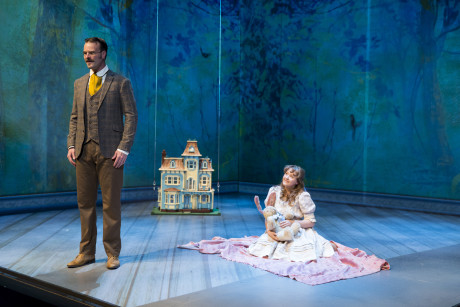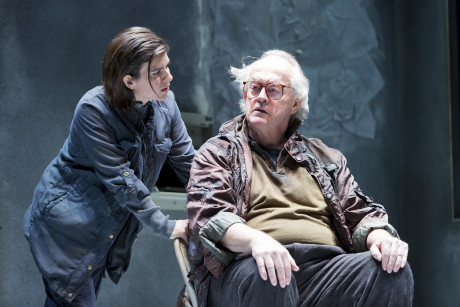Imagine a place where you could be anything you ever dreamed of and do anything you desired in total anonymity and without fear of reprisal or consequence. Imagine the retreat you crave, that you could venture in to whenever you wanted before returning to “real life.” Tempting, isn’t it? This is the world of The Nether, Jennifer Haley’s provocative, mind-bending, bone-chilling play which is being given its Washington, D.C. premiere in a very fine production at Woolly Mammoth Theatre.

In the future, the Earth has been decimated and been left a bleak, grey wasteland. The Nether, an evolution of what we know as the internet, is comprised of a series of online worlds, called “realms.” Individuals visit realms as avatars, plug in and tune out of reality. Experience in the Nether is limited only by imagination. When a character is asked if she feels pain, she responds, “as much as I allow myself to feel.”
As the play begins, Sims (Edward Gero), a portly grandfather type, is being interrogated by a tough, focused detective, Morris (Gabriela Fernandez-Coffey) about a realm he has created called the Hideaway. Sims’ realm is of particular interest to law enforcement, given legislation that has allowed regulation of activity in the Nether. You see, the Hideaway, a 19th Century Victorian wonderland, is a haven for pedophiles to indulge in their deepest, darkest desires, no matter how depraved.
The scenes in Haley’s play cleverly alternate between present and past, as we see the interrogation of Sims, and another member of the Hideaway, Doyle (Paul Vincent O’Connor), who plays a significant part in a plot twist later in the play, and visits to the Hideaway where we meet a handsome stranger, Woodnut(Tim Getman), as well as the object of Sim’s affection, (he is known as Papa in the Nether), a beautiful little girl named Iris (Maya Brettell).
In this tense, tightly wound 80-minute play, Haley asks us to consider the limits of free speech and, perhaps, more importantly free will. Sims confronts Morris and inquires if the Hideaway is bad if it prevents pedophiles from acting on their impulses in real life. When framed that way, I had to wonder, is it? In this way, Sims argues that the Hideaway actually safeguards against harm, while Morris takes the position that it is a gateway to it. She fears that as the lines between real and imagined blur, the activities in the Hideaway will spill out, unleashing a flood that renders reality and fantasy indistinguishable.
Thankfully, Haley doesn’t use her play to take sides in a war between good and evil, right and wrong. That would be far too easy, and predictable. Rather, as she reveals more about the characters and the Nether itself, she keeps shifting the playing field and I found my allegiances and my point of view changing. Just when I thought I felt strongly one way, Haley throws another curveball, and I did a complete 180. This is what keeps the play so interesting and exciting, until its devastating conclusion.

In order for this to work, in part, Director Shana Cooper and her amazing design team, have created, in the Hideaway, a world that is as seductive as it is terrifying. Projection Designer Jared Mezzochi has created a lush, vibrant animated heaven of sorts, using Set Designer Sibyl Wickersheimer’s intricate series of screens and walls as his canvas. Kelsey Hunt’s crisp, period appropriate costumes for the Hideaway harken back to a simpler, innocent time in history, and belie the unspeakable fantasies they give life to. The design elements juxtapose jarringly and most effectively with the cold, gray interrogation room, lit coolly by Colin K. Bills and underscored by pulsing electronic original music and sound design by Eric Shimelonis.
Gero, in his Woolly Mammoth debut, is charged with the difficult task of creating a fully fleshed out, sympathetic character from a man who is, on the surface, a monster. It is a masterful performance. When Gero pleads his case, when he attempts to rationalize his behavior to Morris, I found it very difficult not to be persuaded by him. And, as Papa, in the Hideaway, I began to fall under the spell of his charms until Hayley jolts us back in to the present, allowing us a bit of seduction, but no more. These moments prevent any attachment, something that is frowned up in the Hideaway.
I was equally impressed with Brettell, as the young Iris, a girl who is, perhaps, wise beyond her years and, in fact, not who she seems. No one in The Nether is, not Mr. Getman as Iris’ kind, mysterious suitor Woodnut, who allows his emotions to undermine his own moral center, not the sensational Mr. O’Connor as the broken teacher, Doyle, whose life’s work has been rendered obsolete by technology and who wants to remain in the Hideaway forever, not even Ms. Fernandez-Coffey as Morris, the detective whose life becomes shaken in a way no one could have imagined. If I had one complaint, it’s that while, Ms. Fernandez-Coffey nails Morris’ steely resolve, I didn’t feel that she showed us her vulnerability, or the cracks in her hardness which become especially important in the last third of the play.
Cooper has staged the play seamlessly, marrying the text, design and performances in to a cohesive whole that slowly creeps up on you until, like the characters, you are caught inside of this twisted thriller instead of just watching it. Her attention to detail is astounding, be it the soft focus on a real poplar tree behind one of the set’s transparent walls, or Doyle brushing his cheek during one of the more tender (and disturbing) moments of the play.

67 years ago, George Orwell’s 1984 was published. In it, he imagined a world ravaged by war, under the watchful eye of Big Brother, in which independent thought is a crime. A stage version of that story is currently running around the corner from Woolly Mammoth at the Shakespeare Theatre. Perhaps one could think of The Nether as a type of response to Orwell’s masterwork. It is the pinnacle of independent thought. And Healey demands that we confront its limits. The Nether could take place a month, a year or decades from now, but as our fragile world spins forward at a rapid pace, one thing is certain, these unsettling questions that we could never have dreamed, will require answers sooner than we think.
Running Time: 80 minutes, with no intermission.
The Nether plays through May 1, 2016 at Woolly Mammoth Theatre Company -641 D Street, NW, in Washington, DC. For tickets, call the box office at (202) 393-3939, or purchase them online.
LINKS:
Review: ‘The Nether’ at Woolly Mammoth Theatre Company by David Gerson.
Spine: ‘The Nether’ and its Virtual Revolution at Woolly Mammoth Theatre Company by Robert Michael Oliver.
Magic Time! ‘The Nether’ at Woolly Mammoth Theatre Company by John Stoltenberg.
In the Moment: ‘The Nether’ at Woolly Mammoth Theatre Company on DCMetroTheaterArts by David Siegel.
RATING:





